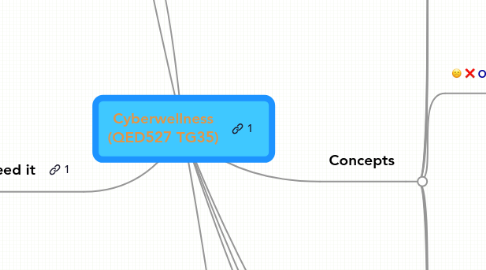
1. Applications
1.1. target group
1.1.1. Secondary students from 13yrs old to 17 yrs old
1.2. YouTube as an educational tool as well as entertainment
2. Definition
2.1. refers to the positive well-being of Internet users
2.2. Safe and responsible use
2.3. involves an understanding of risks of harmful online behaviours
2.4. involves an awareness of how to protect oneself and other Internet users
2.5. Showing respect for self and other users.
2.6. Online security
3. Why we need it
3.1. To educate the students the proper etiquette of using the internet
3.2. Social responsibility
3.3. Protect individuals from harm
3.3.1. financial harm (e.g. scamming/phishing)
3.3.2. emotional harm (e.g. cyberbullying)
3.3.3. physical harm (e.g. unsuspecting youths preyed upon by older adults)
3.4. To maximize the potential of cyberspace
3.5. The progress to a technology enhanced lifestyle makes it inevitable for us to ignore this area of potential threat.
4. General Statistics
4.1. Statistic on Pornography
4.2. Statistic on Addiction
4.3. Statistics on Singaporeans' aware of cyberwellness
5. School - teachers
6. When students are using computers in the class/labs, it is essential for teachers to walk around to observe that students are on the right track and are focused on task and not viewing prohibited websites. If a student is caught, it's important to counsel the student about using cyberspace in an appropriate and responsible manner.
7. Filtering system for parental control
7.1. But, can't some filtering systems be turned off easily by others? How do we go about the problem then? There is a passwork locking system available?
8. Concepts
8.1. Cyberbullying
8.1.1. Making derogatory remarks about the child online on blogs or forums
8.1.2. Constantly killing the child's character in the game by a bully causing frustration and anxiety to the child
8.1.3. What is cyberbullying?
8.2. Privacy and human rights
8.2.1. Privacy? What really is privacy? Please see the link:
8.3. Cyber gaming
8.3.1. Online gambling
8.3.2. Educational games
8.4. Cyber stalking
8.5. Addiction
8.5.1. constant need to check emails
8.5.2. Online gaming for long hours
8.5.3. constant need to chat
8.6. Online child pornography
8.6.1. What is it?
8.6.1.1. "Defined as any visual depiction, including any photograph, film, video, picture, or computer or computer-generated image or picture, whether made or produced by electronic, mechanical, or other means, of sexually explicit conduct."
8.6.2. Effects
8.6.2.1. On the child
8.6.2.1.1. "It is important to realize that these images are crime scene photos – they are a permanent record of the abuse of a child. The lives of the children featured in these illegal images and videos are forever altered. Once these images are on the Internet, they are irretrievable and can continue to circulate forever. The child is revictimized as the images are viewed again and again. "
8.6.2.2. On society
8.6.3. What is being done?
8.6.3.1. State level
8.6.3.1.1. Laws against the propagation of child pornography
8.6.3.2. Online
8.6.3.2.1. Websites created to increase awareness on the horrors of child pornography and to protect children online
8.6.3.3. NGOs
8.6.3.3.1. UNICEF
8.6.3.4. How about the role of family?
8.6.3.4.1. Parents to play an active role in protecting their children's identities online. Parents should also ensure that their children are not communicating with dubious people online through restricting the kinds of webpages their children are allowed to visit, limiting the amount of time their children spend on the internet etc.
8.6.3.4.2. Parents should try to get involved with their child's internet usage. Surf the internet with the child so as to simultaneously educate the child on usage.
8.7. Security
8.7.1. Disclosing personal information online
8.7.2. gmail / twitter hack
8.7.3. Phishing
8.7.3.1. Recognizing Phishing
8.7.4. using social networking widgets for hacking and criminal activities
8.7.4.1. difficulty in tracking user movement online
8.7.4.2. Hackers targeting social networks due to its extensive amount of personal information / Hacking as a lucrative income / cyber crime mafias
8.7.4.2.1. Technology
8.8. Online Slandering through blogs
8.9. Copyright
8.9.1. property and ownership issues
8.10. Internet integrity (information)
8.10.1. Racism on the internet
8.10.2. Spam
8.10.3. Virus
8.11. Online dating
8.11.1. Dating system which allows individuals, couples, groups to make contact and communicate with each other over the internet.
8.11.1.1. Objective: developing a personal, romantic or sexual relationship
8.11.1.2. Problem: Members profiles may not be real and there is great distrust, of age, gender, marital status, photographs. It can lead to stalking, fraud, sexual violence as young teens can easily be taken advantage of by online predators.
